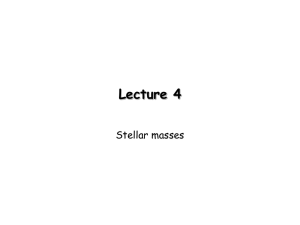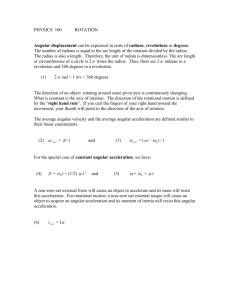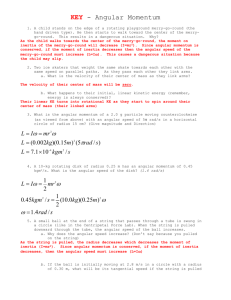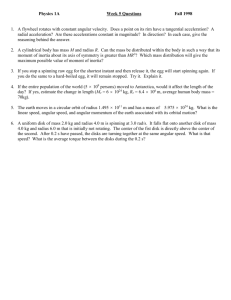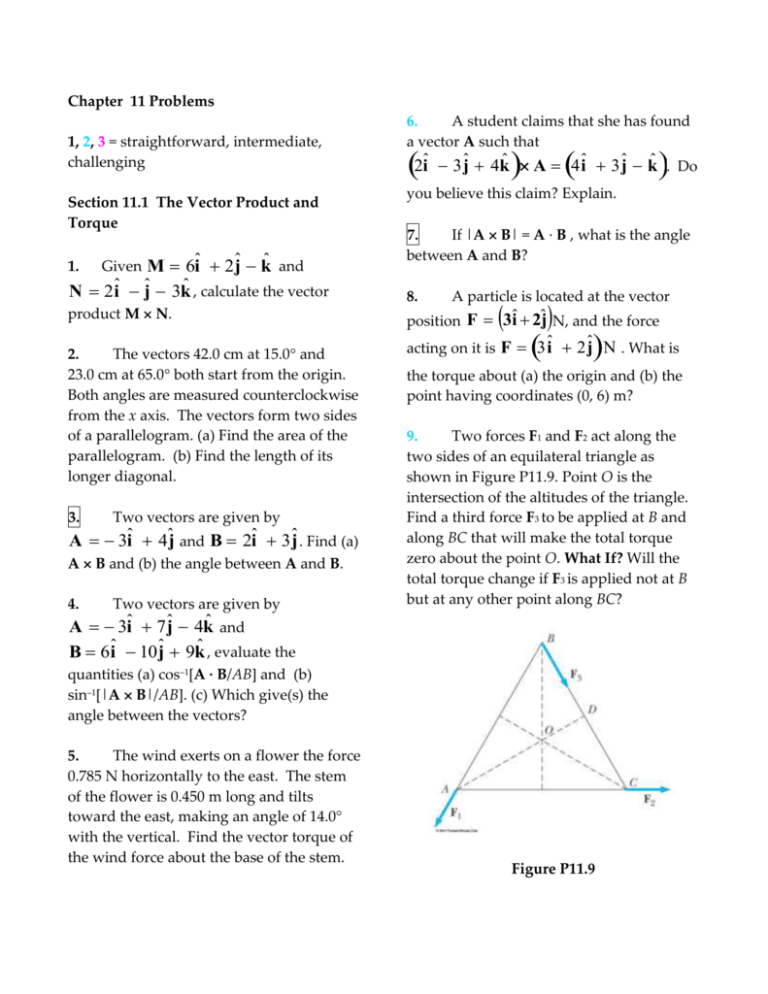
Chapter 11 Problems
1, 2, 3 = straightforward, intermediate,
challenging
Section 11.1 The Vector Product and
Torque
1.
ˆ and
Given M 6ˆi 2 ˆj k
N 2 ˆi ˆj 3kˆ , calculate the vector
product M N.
2.
The vectors 42.0 cm at 15.0 and
23.0 cm at 65.0 both start from the origin.
Both angles are measured counterclockwise
from the x axis. The vectors form two sides
of a parallelogram. (a) Find the area of the
parallelogram. (b) Find the length of its
longer diagonal.
3.
Two vectors are given by
A 3ˆi 4ˆj and B 2ˆi 3 ˆj . Find (a)
A B and (b) the angle between A and B.
4.
Two vectors are given by
6.
A student claims that she has found
a vector A such that
2ˆi 3 ˆj 4kˆ A 4 ˆi 3 ˆj kˆ . Do
you believe this claim? Explain.
7.
If |A B| = A · B , what is the angle
between A and B?
8.
A particle is located at the vector
position F 3ˆi 2ˆj N, and the force
acting on it is F 3 ˆi 2 ˆj N . What is
the torque about (a) the origin and (b) the
point having coordinates (0, 6) m?
9.
Two forces F1 and F2 act along the
two sides of an equilateral triangle as
shown in Figure P11.9. Point O is the
intersection of the altitudes of the triangle.
Find a third force F3 to be applied at B and
along BC that will make the total torque
zero about the point O. What If? Will the
total torque change if F3 is applied not at B
but at any other point along BC?
A 3ˆi 7 ˆj 4kˆ and
B 6 ˆi 10 ˆj 9kˆ , evaluate the
quantities (a) cos–1[A · B/AB] and (b)
sin–1[|A B|/AB]. (c) Which give(s) the
angle between the vectors?
5.
The wind exerts on a flower the force
0.785 N horizontally to the east. The stem
of the flower is 0.450 m long and tilts
toward the east, making an angle of 14.0°
with the vertical. Find the vector torque of
the wind force about the base of the stem.
Figure P11.9
10.
Use the definition of the vector
product and the definitions of the unit
vectors ˆi , ˆj , and kˆ to prove Equations
11.7. You may assume that the x axis points
to the right, the y axis up, and the z axis
toward you (not away from you). This
choice is said to make the coordinate
system right-handed.
particle's angular momentum when its
position vector is r 1.50 ˆi 2.20 ˆj m .
13.
The position vector of a particle of
mass 2.00 kg is given as a function of time
by r 6.00ˆi 5.00t ˆj m . Determine the
angular momentum of the particle about
the origin, as a function of time.
Section 11.2 Angular Momentum
11.
A light rigid rod 1.00 m in length
joins two particles, with masses 4.00 kg and
3.00 kg, at its ends. The combination
rotates in the xy plane about a pivot
through the center of the rod (Fig. P11.11).
Determine the angular momentum of the
system about the origin when the speed of
each particle is 5.00 m/s.
14.
A conical pendulum consists of a
bob of mass m in motion in a circular path
in a horizontal plane as shown in Figure
P11.14. During the motion, the supporting
wire of length maintains the constant
angle with the vertical. Show that the
magnitude of the angular momentum of the
bob about the center of the circle is
m 2 g 3 sin 4
L
cos
1/ 2
Figure P11.11
12.
A 1.50-kg particle moves in the xy
plane with a velocity of
v 4.20 ˆi 3.60 ˆj m / s . Determine the
Figure P11.14
15.
A particle of mass m moves in a
circle of radius R at a constant speed v, as
shown in Figure P11.15. If the motion
begins at point Q at time t = 0, determine
the angular momentum of the particle
about point P as a function of time.
particle is (a) at the origin, (b) at the highest
point of its trajectory, and (c) just before it
hits the ground. (d) What torque causes its
angular momentum to change?
Figure P11.17
Figure P11.15
16.
A 4.00-kg counterweight is attached
to a light cord, which is wound around a
spool (refer to Fig. 10.20). The spool is a
uniform solid cylinder of radius 8.00 cm
and mass 2.00 kg. (a) What is the net
torque on the system about the point O?
(b) When the counterweight has a speed v,
the pulley has an angular speed = v/R.
Determine the total angular momentum of
the system about O. (c) Using the fact that
= dL/dt and your result from (b), calculate
the acceleration of the counterweight.
17.
A particle of mass m is shot with an
initial velocity vi making an angle with
the horizontal as shown in Figure P11.17.
The particle moves in the gravitational field
of the Earth. Find the angular momentum
of the particle about the origin when the
18.
Heading straight toward the summit
of Pike’s Peak, an airplane of mass
12 000 kg flies over the plains of Kansas at
nearly constant altitude 4.30 km, with
constant velocity 175 m/s west. (a) What is
the airplane's vector angular momentum
relative to a wheat farmer on the ground
directly below the airplane? (b) Does this
value change as the airplane continues its
motion along a straight line? (c) What If?
What is its angular momentum relative to
the summit of Pike’s Peak?
19.
A ball having mass m is fastened at
the end of a flagpole that is connected to the
side of a tall building at point P shown in
Figure P11.19. The length of the flagpole is
and it makes an angle with the
horizontal. If the ball becomes loose and
starts to fall, determine the angular
momentum (as a function of time) of the
ball about point P. Neglect air resistance.
3.00 rad/s.
23.
A uniform solid disk of mass 3.00 kg
and radius 0.200 m rotates about a fixed
axis perpendicular to its face. If the angular
frequency of rotation is 6.00 rad/s, calculate
the angular momentum of the disk when
the axis of rotation (a) passes through its
center of mass and (b) passes through a
point midway between the center and the
rim.
Figure P11.19
20.
A fireman clings to a vertical ladder
and directs the nozzle of a hose
horizontally toward a burning building.
The rate of water flow is 6.31 kg/s, and the
nozzle speed is 12.5 m/s. The hose passes
vertically between the fireman’s feet, which
are 1.30 m below the nozzle. Choose the
origin to be inside the hose between the
fireman’s feet. What torque must the
fireman exert on the hose? That is, what is
the rate of change of the angular
momentum of the water?
Section 11.3 Angular Momentum of a
Rotating Rigid Object
21.
Show that the kinetic energy of an
object rotating about a fixed axis with
angular momentum L = I can be written
as K = L2/2I .
22.
A uniform solid sphere of radius
0.500 m and mass 15.0 kg turns
counterclockwise about a vertical axis
through its center. Find its vector angular
momentum when its angular speed is
24.
Big Ben, the Parliament Building
tower clock in London, has hour and
minute hands with lengths of 2.70 m and
4.50 m and masses of 60.0 kg and 100 kg,
respectively. Calculate the total angular
momentum of these hands about the center
point. Treat the hands as long thin uniform
rods.
25.
A particle of mass 0.400 kg is
attached to the 100-cm mark of a meter
stick of mass 0.100 kg. The meter stick
rotates on a horizontal, frictionless table
with an angular speed of 4.00 rad/s.
Calculate the angular momentum of the
system when the stick is pivoted about an
axis (a) perpendicular to the table through
the 50.0-cm mark and (b) perpendicular to
the table through the 0-cm mark.
26.
The distance between the centers of
the wheels of a motorcycle is 155 cm. The
center of mass of the motorcycle, including
the biker, is 88.0 cm above the ground and
halfway between the wheels. Assume the
mass of each wheel is small compared to
the body of the motorcycle. The engine
drives the rear wheel only. What
horizontal acceleration of the motorcycle
will make the front wheel rise off the
ground?
27.
A space station is constructed in the
shape of a hollow ring of mass 5.00 104 kg.
Members of the crew walk on a deck
formed by the inner surface of the outer
cylindrical wall of the ring, with radius
100 m. At rest when constructed, the ring is
rotated about its axis so that the people
inside experience an effective free-fall
acceleration equal to g. (Figure P11.27
shows the ring together with some other
parts that make a negligible contribution to
the total moment of inertia.) The rotation is
achieved by firing two small rockets
attached tangentially to opposite points on
the outside of the ring. (a) What angular
momentum does the space station acquire?
(b) How long must the rockets be fired if
each exerts a thrust of 125 N? (c) Prove that
the total torque on the ring, multiplied by
the time interval found in part (b), is equal
to the change in angular momentum, found
in part (a). This equality represents the
angular impulse–angular momentum theorem.
Figure P11.27 Problems 27 and 36
Section 11.4 Conservation of Angular
Momentum
28.
A cylinder with moment of inertia I1
rotates about a vertical, frictionless axle
with angular velocity i. A second
cylinder, this one having moment of inertia
I2 and initially not rotating, drops onto the
first cylinder (Fig. P11.28). Because of
friction between the surfaces, the two
eventually reach the same angular velocity
f. (a) Calculate f. (b) Show that the
kinetic energy of the system decreases in
this interaction and calculate the ratio of the
final to the initial rotational energy.
Figure P11.28
29.
A playground merry-go-round of
radius R = 2.00 m has a moment of inertia
I = 250 kg·m2 and is rotating at 10.0 rev/min
about a frictionless vertical axle. Facing the
axle, a 25.0-kg child hops onto the merrygo-round and manages to sit down on the
edge. What is the new angular speed of the
merry-go-round?
30.
A student sits on a freely rotating
stool holding two weights, each of mass
3.00 kg (Figure P11.30). When his arms are
extended horizontally, the weights are
1.00 m from the axis of rotation and he
rotates with an angular speed of 0.750
rad/s. The moment of inertia of the student
plus stool is 3.00 kg·m2 and is assumed to
be constant. The student pulls the weights
inward horizontally to a position 0.300 m
from the rotation axis. (a) Find the new
angular speed of the student. (b) Find the
kinetic energy of the rotating system before
and after he pulls the weights inward.
Figure P11.30
31.
A uniform rod of mass 100 g and
length 50.0 cm rotates in a horizontal plane
about a fixed, vertical, frictionless pin
through its center. Two small beads, each of
mass 30.0 g, are mounted on the rod so that
they are able to slide without friction along
its length. Initially the beads are held by
catches at positions 10.0 cm on each side of
center, at which time the system rotates at
an angular speed of 20.0 rad/s. Suddenly,
the catches are released and the small beads
slide outward along the rod. Find (a) the
angular speed of the system at the instant
the beads reach the ends of the rod and (b)
What if the beads fly off the ends? What is
the angular speed of the rod after this
occurs?
32.
An umbrella consists of a circle of
cloth, a thin rod with the handle at one end
and the center of the cloth at the other end,
and several straight uniform ribs hinged to
the top end of the rod and holding the cloth
taut. With the ribs perpendicular to the
rod, the umbrella is set rotating about the
rod with an angular speed of 1.25 rad/s.
The cloth is so light and the rod is so thin
that they make negligible contributions to
the moment of inertia, in comparison to the
ribs. The spinning umbrella is balanced on
its handle and keeps rotating without
friction. Suddenly its latch breaks and the
umbrella partly folds up, until each rib
makes an angle of 22.5 with the rod. What
is the final angular speed of the umbrella?
33.
A 60.0-kg woman stands at the rim
of a horizontal turntable having a moment
of inertia of 500 kg·m2 and a radius of
2.00 m. The turntable is initially at rest and
is free to rotate about a frictionless, vertical
axle through its center. The woman then
starts walking around the rim clockwise (as
viewed from above the system) at a
constant speed of 1.50 m/s relative to the
Earth. (a) In what direction and with what
angular speed does the turntable rotate? (b)
How much work does the woman do to set
herself and the turntable into motion?
34.
A puck of mass 80.0 g and radius
4.00 cm slides along an air table at a speed
of 1.50 m/s as shown in Figure P11.34a. It
makes a glancing collision with a second
puck of radius 6.00 cm and mass 120 g
(initially at rest) such that their rims just
touch. Because their rims are coated with
instant-acting glue, the pucks stick together
and spin after the collision (Fig. P11.34b).
(a) What is the angular momentum of the
system relative to the center of mass? (b)
What is the angular speed about the center
of mass?
Figure P11.34
35.
A wooden block of mass M resting
on a frictionless horizontal surface is
attached to a rigid rod of length and of
negligible mass (Fig. P11.35). The rod is
pivoted at the other end. A bullet of mass m
traveling parallel to the horizontal surface
and normal to the rod with speed v hits the
block and becomes embedded in it. (a)
What is the angular momentum of the
bullet-block system? (b) What fraction of
the original kinetic energy is lost in the
collision?
Figure P11.35
36.
A space station shaped like a giant
wheel has a radius of 100 m and a moment
of inertia of 5.00 108 kg·m2. A crew of 150
is living on the rim, and the station’s
rotation causes the crew to experience an
apparent free-fall acceleration of 1 g (Fig.
P11.27). When 100 people move to the
center of the station for a union meeting,
the angular speed changes. What apparent
free-fall acceleration is experienced by the
managers remaining at the rim? Assume
that the average mass for each inhabitant is
65.0 kg.
37.
A wad of sticky clay with mass m
and velocity vi is fired at a solid cylinder of
mass M and radius R (Figure P11.37). The
cylinder is initially at rest, and is mounted
on a fixed horizontal axle that runs through
its center of mass. The line of motion of the
projectile is perpendicular to the axle and at
a distance d < R from the center. (a) Find
the angular speed of the system just after
the clay strikes and sticks to the surface of
the cylinder. (b) Is mechanical energy of
the clay-cylinder system conserved in this
process? Explain your answer.
Section 11.5 The Motion of Gyroscopes
and Tops
Figure P11.37
38.
A thin uniform rectangular sign
hangs vertically above the door of a shop.
The sign is hinged to a stationary horizontal
rod along its top edge. The mass of the sign
is 2.40 kg and its vertical dimension is
50.0 cm. The sign is swinging without
friction, becoming a tempting target for
children armed with snowballs. The
maximum angular displacement of the sign
is 25.0 on both sides of the vertical. At a
moment when the sign is vertical and
moving to the left, a snowball of mass
400 g, traveling horizontally with a velocity
of 160 cm/s to the right, strikes
perpendicularly the lower edge of the sign
and sticks there. (a) Calculate the angular
speed of the sign immediately before the
impact. (b) Calculate its angular speed
immediately after the impact. (c) The
spattered sign will swing up through what
maximum angle?
39.
Suppose a meteor of mass
3.00 1013 kg, moving at 30.0 km/s relative
to the center of the Earth, strikes the Earth.
What is the order of magnitude of the
maximum possible decrease in the angular
velocity of the Earth due to this collision?
Explain your answer.
40.
A spacecraft is in empty space. It
carries on board a gyroscope with a
moment of inertia of Ig = 20.0 kg·m2 about
the axis of the gyroscope. The moment of
inertia of the spacecraft around the same
axis is Is = 5.00 105 kg·m2. Neither the
spacecraft nor the gyroscope is originally
rotating. The gyroscope can be powered up
in a negligible period of time to an angular
speed of 100 s1. If the orientation of the
spacecraft is to be changed by 30.0, for
how long should the gyroscope be
operated?
41.
The angular momentum vector of a
precessing gyroscope sweeps out a cone, as
in Figure 11.14b. Its angular speed, called
its precessional frequency, is given by
p = /L, where is the magnitude of the
torque on the gyroscope and L is the
magnitude of its angular momentum. In
the motion called precession of the equinoxes,
the Earth’s axis of rotation precesses about
the perpendicular to its orbital plane with a
period of 2.58 104 yr. Model the Earth as a
uniform sphere and calculate the torque on
the Earth that is causing this precession.
Section 11.6 Angular Momentum as a
Fundamental Quantity
42.
In the Bohr model of the hydrogen
atom, the electron moves in a circular orbit
of radius 0.529 10–10 m around the proton.
Assuming the orbital angular momentum
of the electron is equal to h/2 , calculate (a)
the orbital speed of the electron, (b) the
kinetic energy of the electron, and (c) the
angular frequency of the electron’s motion.
Additional Problems
43.
We have all complained that there
aren’t enough hours in a day. In an attempt
to change that, suppose that all the people
in the world line up at the equator, and all
start running east at 2.50 m/s relative to the
surface of the Earth. By how much does the
length of a day increase? Assume that the
world population is 5.50 109 people with
an average mass of 70.0 kg each, and that
the Earth is a solid homogeneous sphere. In
addition, you may use the approximation
1/(1 – x) 1 + x for small x.
44.
A skateboarder with his board can
be modeled as a particle of mass 76.0 kg,
located at his center of mass. As shown in
Figure P8.67 on page 248, the skateboarder
starts from rest in a crouching position at
one lip of a half-pipe (point A). The halfpipe forms one half of a cylinder of radius
6.80 m with its axis horizontal. On his
descent, the skateboarder moves without
friction and maintains his crouch, so that
his center of mass moves through one
quarter of a circle of radius 6.30 m. (a) Find
his speed at the bottom of the half-pipe
(point B). (b) Find his angular momentum
about the center of curvature. (c)
Immediately after passing point B, he
stands up and raises his arms, lifting his
center of gravity from 0.500 m to 0.950 m
above the concrete (point C). Explain why
his angular momentum is constant in this
maneuver, while his linear momentum and
his mechanical energy are not constant. (d)
Find his speed immediately after he stands
up, when his center of mass is moving in a
quarter circle of radius 5.85 m. (e) What
work did the skateboarder’s legs do on his
body as he stood up? Next, the
skateboarder glides upward with his center
of mass moving in a quarter circle of radius
5.85 m. His body is horizontal when he
passes point D, the far lip of the half-pipe.
(f) Find his speed at this location. At last he
goes ballistic, twisting around while his
center of mass moves vertically. (g) How
high above point D does he rise? (h) Over
what time interval is he airborne before he
touches down, facing downward and again
in a crouch, 2.34 m below the level of point
D? (i) Compare the solution to this
problem with the solution to Problem 8.67.
Which is more accurate? Why? (Caution:
Do not try this yourself without the
required skill and protective equipment, or
in a drainage channel to which you do not
have legal access.)
45.
A rigid, massless rod has three
particles with equal masses attached to it as
shown in Figure P11.45. The rod is free to
rotate in a vertical plane about a frictionless
axle perpendicular to the rod through the
point P, and is released from rest in the
horizontal position at t = 0. Assuming m
and d are known, find (a) the moment of
inertia of the system (rod plus particles)
about the pivot, (b) the torque acting on the
system at t = 0, (c) the angular acceleration
of the system at t = 0, (d) the linear
acceleration of the particle labeled 3 at t = 0,
(e) the maximum kinetic energy of the
system, (f) the maximum angular speed
reached by the rod, (g) the maximum
angular momentum of the system, and (h)
the maximum speed reached by the particle
labeled 2.
during the 440-s motion. (g) Find the work
done by the string brake on the sliding
block. (h) Find the total work on the system
consisting of the disk and the sliding block.
Figure P11.45
46.
A 100-kg uniform horizontal disk of
radius 5.50 m turns without friction at
2.50 rev/s on a vertical axis through its
center, as in Figure P11.46. A feedback
mechanism senses the angular speed of the
disk and a drive motor at A maintains the
angular speed constant, while a 1.20-kg
block on top of the disk slides outward in a
radial slot. The 1.20-kg block starts at the
center of the disk at time t = 0 and moves
outward with constant speed 1.25 cm/s
relative to the disk until it reaches the edge
at t = 440 s. The sliding block feels no
friction. Its motion is constrained to have
constant radial speed by a brake at B,
producing tension in a light string tied to
the block. (a) Find the torque that the drive
motor must provide as a function of time,
while the block is sliding. (b) Find the
value of this torque at t = 440 s, just before
the sliding block finishes its motion. (c)
Find the power that the drive motor must
deliver as a function of time. (d) Find the
value of the power when the sliding block
is just reaching the end of the slot. (e) Find
the string tension as a function of time. (f)
Find the work done by the drive motor
Figure P11.46
47.
Comet Halley moves about the Sun
in an elliptical orbit, with its closest
approach to the Sun being about 0.590 AU
and its greatest distance 35.0 AU
(1 AU = the Earth-Sun distance). If the
comet's speed at closest approach is
54.0 km/s, what is its speed when it is
farthest from the Sun? The angular
momentum of the comet about the Sun is
conserved, because no torque acts on the
comet. The gravitational force exerted by
the Sun has zero moment arm.
48.
A light rope passes over a light,
frictionless pulley. One end is fastened to a
bunch of bananas of mass M, and a monkey
of mass M clings to the other end (Fig.
P11.48). The monkey climbs the rope in an
attempt to reach the bananas. (a) Treating
the system as consisting of the monkey,
bananas, rope, and pulley, evaluate the net
torque about the pulley axis. (b) Using the
results of (a), determine the total angular
momentum about the pulley axis and
describe the motion of the system. Will the
monkey reach the bananas?
Figure P11.49
Figure P11.48
49.
A puck of mass m is attached to a
cord passing through a small hole in a
frictionless, horizontal surface (Fig. P11.49).
The puck is initially orbiting with speed vi
in a circle of radius ri. The cord is then
slowly pulled from below, decreasing the
radius of the circle to r. (a) What is the
speed of the puck when the radius is r? (b)
Find the tension in the cord as a function of
r. (c) How much work W is done in moving
m from ri to r? (Note: The tension depends
on r.) (d) Obtain numerical values for v, T,
and W when r = 0.100 m, m = 50.0 g,
ri = 0.300 m, and vi = 1.50 m/s.
50.
A projectile of mass m moves to the
right with a speed vi (Fig. P11.50a). The
projectile strikes and sticks to the end of a
stationary rod of mass M, length d, pivoted
about a frictionless axle through its center
(Fig. P11.50b). (a) Find the angular speed of
the system right after the collision. (b)
Determine the fractional loss in mechanical
energy due to the collision.
Figure P11.50
51
Two astronauts (Fig. P11.51), each
having a mass of 75.0 kg, are connected by
a 10.0-m rope of negligible mass. They are
isolated in space, orbiting their center of
mass at speeds of 5.00 m/s. Treating the
astronauts as particles, calculate (a) the
magnitude of the angular momentum of the
system and (b) the rotational energy of the
system. By pulling on the rope, one of the
astronauts shortens the distance between
them to 5.00 m. (c) What is the new angular
momentum of the system? (d) What are the
astronauts’ new speeds? (e) What is the
new rotational energy of the system? (f)
How much work does the astronaut do in
shortening the rope?
Figure P11.51 Problems 51 and 52
52.
Two astronauts (Fig. P11.51), each
having a mass M, are connected by a rope
of length d having negligible mass. They are
isolated in space, orbiting their center of
mass at speeds v. Treating the astronauts
as particles, calculate (a) the magnitude of
the angular momentum of the system and
(b) the rotational energy of the system. By
pulling on the rope, one of the astronauts
shortens the distance between them to d/2.
(c) What is the new angular momentum of
the system? (d) What are the astronauts’
new speeds? (e) What is the new rotational
energy of the system? (f) How much work
does the astronaut do in shortening the
rope?
53.
Global warming is a cause for
concern because even small changes in the
Earth’s temperature can have significant
consequences. For example, if the Earth’s
polar ice caps were to melt entirely, the
resulting additional water in the oceans
would flood many coastal cities. Would it
appreciably change the length of a day?
Calculate the resulting change in the
duration of one day. Model the polar ice as
having mass 2.30 1019 kg and forming two
flat disks of radius 6.00 105 m. Assume
the water spreads into an unbroken thin
spherical shell after it melts.
54.
A solid cube of wood of side 2a and
mass M is resting on a horizontal surface.
The cube is constrained to rotate about an
axis AB (Fig. P11.54). A bullet of mass m
and speed v is shot at the face opposite
ABCD at a height of 4a/3. The bullet
becomes embedded in the cube. Find the
minimum value of v required to tip the
cube so that it falls on face ABCD. Assume
m << M.
Figure P11.54
55.
A solid cube of side 2a and mass M is
sliding on a frictionless surface with
uniform velocity v as in Figure P11.55a. It
hits a small obstacle at the end of the table,
which causes the cube to tilt as in Figure
P11.55b. Find the minimum value of v such
that the cube falls off the table. Note that
the moment of inertia of the cube about an
axis along one of its edges is 8Ma2/3. (Hint:
The cube undergoes an inelastic collision at
the edge.)
Figure P11.56. (a) What is the angular speed
of the disk once pure rolling takes place? (b)
Find the fractional loss in kinetic energy
from the time the disk is released until pure
rolling occurs. (Hint: Consider torques
about the center of mass.)
Figure P11.56
Figure P11.55
56.
A uniform solid disk is set into
rotation with an angular speed i about an
axis through its center. While still rotating
at this speed, the disk is placed into contact
with a horizontal surface and released as in
© Copyright 2004 Thomson. All rights reserved.
57.
Suppose a solid disk of radius R is
given an angular speed i about an axis
through its center and then lowered to a
horizontal surface and released, as in
Problem 56 (Fig. P11.56). Furthermore,
assume that the coefficient of friction
between disk and surface is . (a) Show
that the time interval before pure rolling
motion occurs is R i/3 g. (b) Show that
the distance the disk travels before pure
rolling occurs is R2 i2/18 g.



